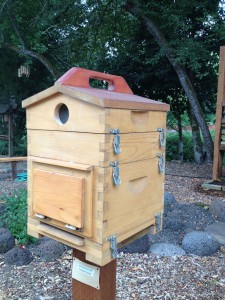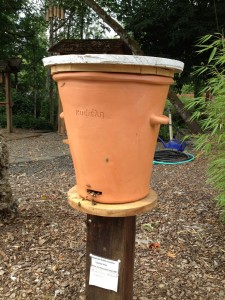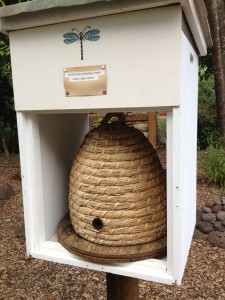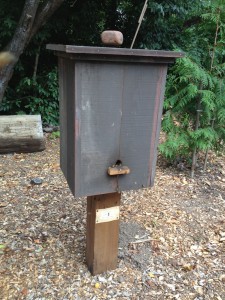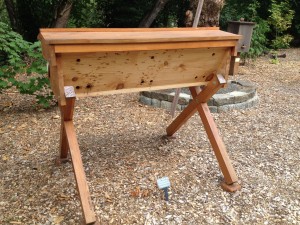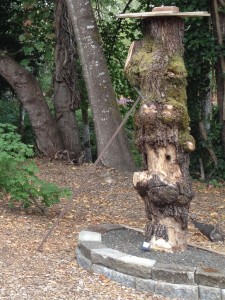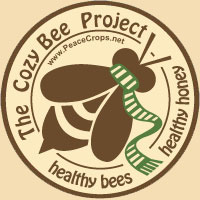As I may have mentioned before, I am studying in the Master Beekeeper program at Oregon State. It’s a cool program: you get access to top-level apicultural scientists like Dewey Caron and Ramesh Sagili, attend really interesting lectures and training sessions, network with large-scale beekeepers (thousands of hives), get advice from old-timers (20+ years of experience), and participate in social service activities like community teaching and judging honey at the state fair.
This weekend was the annual Mentor Field Day. I’ve signed up to be a “mentor”, to help really new beekeepers get started. The Master Beekeeper program wants to be sure that the new apprentices get a uniform exposure to all the information, so all the mentors are brought together to discuss what we’ll be teaching, as well as filling in the gaps that each of us have in our own bee knowledge. But the best part? They host it at the OSU experimental apiary. It’s really cool: a bee yard at the university, a gorgeous garden filled with exotic and experimental hives (I’ll show a bunch of pictures at the end of the post).
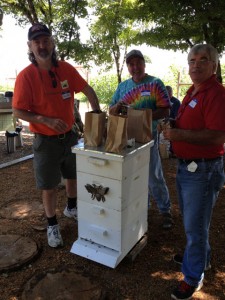 We were told to bring lawn chairs for the day, as the lectures were going to be out in the sunny garden. As I set up my chair, it was amusing to me to realize that we had 40 people sitting on the grass, in the middle of a few dozen hives, bees zinging around every which way, landing on notebooks and lecturers, and everyone was totally cool with that. This is one of those classes where a non-beekeeper would probably have NOT been comfortable. To give you an idea, here’s a picture of three of the beekeepers during our lunch break, having their lunch RIGHT ON ONE OF THE HIVES. Heh.
We were told to bring lawn chairs for the day, as the lectures were going to be out in the sunny garden. As I set up my chair, it was amusing to me to realize that we had 40 people sitting on the grass, in the middle of a few dozen hives, bees zinging around every which way, landing on notebooks and lecturers, and everyone was totally cool with that. This is one of those classes where a non-beekeeper would probably have NOT been comfortable. To give you an idea, here’s a picture of three of the beekeepers during our lunch break, having their lunch RIGHT ON ONE OF THE HIVES. Heh.
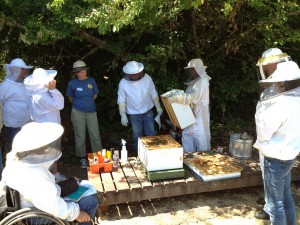 After an hour or two of discussion relating to modern beekeeping practices and the specifics of how to teach them, we broke up into work groups to do some hands on training. This is the part where most people broke out their bee suits, and we opened up a few hives. Notice I say “most people”; some bee whisperers don’t use bee suits. This is another fun thing about the program, you get to meet a lot of people with really different beekeeping techniques and backgrounds. In this picture, you see a disabled beekeeper, a suitless beekeeper, and a Japanese beekeeper with a ventilated suit.
After an hour or two of discussion relating to modern beekeeping practices and the specifics of how to teach them, we broke up into work groups to do some hands on training. This is the part where most people broke out their bee suits, and we opened up a few hives. Notice I say “most people”; some bee whisperers don’t use bee suits. This is another fun thing about the program, you get to meet a lot of people with really different beekeeping techniques and backgrounds. In this picture, you see a disabled beekeeper, a suitless beekeeper, and a Japanese beekeeper with a ventilated suit.
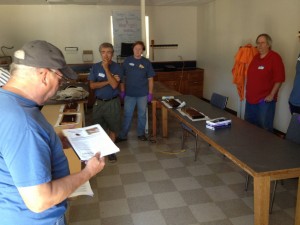 We also went into the classroom. Here we see Dewey Caron discussing American Foulbrood, a particularly nasty bee disease. It’s basically the Black Plague for bees… an extremely contagious disease with spores that can survive for up to 40 years and are largely immune to sanitizers and bleach. It’s so bad that the “treatment” is to seal the hive at night when the bees are all at home, and burn it to the ground. That’s it. It’s due to this disease that skep hives (the basket-looking things you see in cartoons) are illegal in most states, as you can’t take them apart to inspect for Foulbrood. Today, we’re looking at some frames of actual foulbrood from the freezer of the bee lab, and we’re taking extreme sanitary precautions as a result. There are several field identification tests for foulbrood, but one of them is smell. Once the frame started thawing, you could definitely smell a stinky cheese odor wafting through the air.
We also went into the classroom. Here we see Dewey Caron discussing American Foulbrood, a particularly nasty bee disease. It’s basically the Black Plague for bees… an extremely contagious disease with spores that can survive for up to 40 years and are largely immune to sanitizers and bleach. It’s so bad that the “treatment” is to seal the hive at night when the bees are all at home, and burn it to the ground. That’s it. It’s due to this disease that skep hives (the basket-looking things you see in cartoons) are illegal in most states, as you can’t take them apart to inspect for Foulbrood. Today, we’re looking at some frames of actual foulbrood from the freezer of the bee lab, and we’re taking extreme sanitary precautions as a result. There are several field identification tests for foulbrood, but one of them is smell. Once the frame started thawing, you could definitely smell a stinky cheese odor wafting through the air.
In all, it was a great time. Now I’ll follow up with some of those hive pictures I was talking about earlier. Enjoy!


